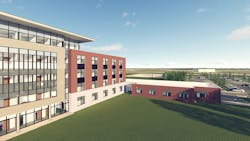Three votes cast by the Texas A&M University System's Board of Regents may have changed the way that the U.S. Army prepares for future combat. The Regents members voted to amend the school system’s capital budget, adding $79.3 million to build this country’s largest enclosed-tube hypersonic testing facility and test grounds on the school’s RELLIS campus. The experimental center will aid the Army Futures Command’s modernization mission by allowing soldiers from Fort Hood and the Texas A&M’s Corps of Cadets to test high-speed prototypes within the enclosed-tube structure. Construction of the facility, part of the Bush Combat Development Complex, is scheduled to begin in the Fall of 2020. The Texas A&M University System is a network of 11 universities spread across the state.
“This is a historic vote,” said John Sharp, chancellor of the Texas A&M University System. “Today’s vote will not only transform Texas A&M and the RELLIS campus, it will transform Central Texas and the U.S. Army.” The Army is hoping that the $200 million Bush Combat Development Center contributes to an accelerated procurement process, making possible faster design and test cycles. In addition to the Texas A&M Regents vote, the 86th Texas State Legislature appropriated $50 million to Governor Greg Abbott to transfer to Texas A&M Engineering Experimental Station (TEES) for Army Futures Command efforts.
Elaine Mendoza, chairman of the Texas A&M System board, noted: “Texas A&M and the RELLIS campus will become a nexus for collaboration and high-tech testing in service to our nation’s security. Today’s vote will bring hundreds of millions worth of private investment to Central Texas as these facilities come to life. Simply put, this is where American defense contractors will want to set up shop if they want to work with the U.S. Army Futures Command.” The kilometer-long hypersonic test structure will make it possible to explore the effects of such speeds on materials and system structures. The enclosed tube will be supported by laboratories, runways, and underground and open-air ranges to explore high-speed aircraft designs.
About the Author
Jack Browne
Technical Contributor
Jack Browne, Technical Contributor, has worked in technical publishing for over 30 years. He managed the content and production of three technical journals while at the American Institute of Physics, including Medical Physics and the Journal of Vacuum Science & Technology. He has been a Publisher and Editor for Penton Media, started the firm’s Wireless Symposium & Exhibition trade show in 1993, and currently serves as Technical Contributor for that company's Microwaves & RF magazine. Browne, who holds a BS in Mathematics from City College of New York and BA degrees in English and Philosophy from Fordham University, is a member of the IEEE.
